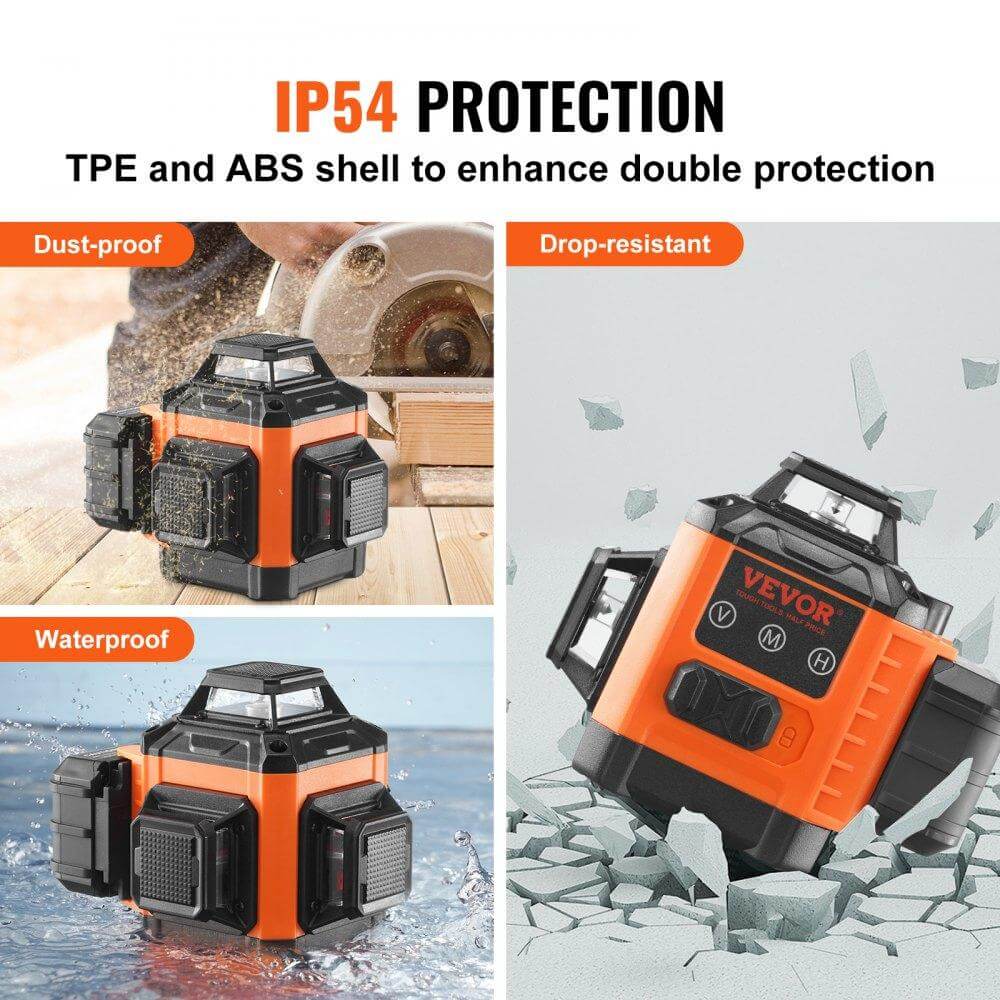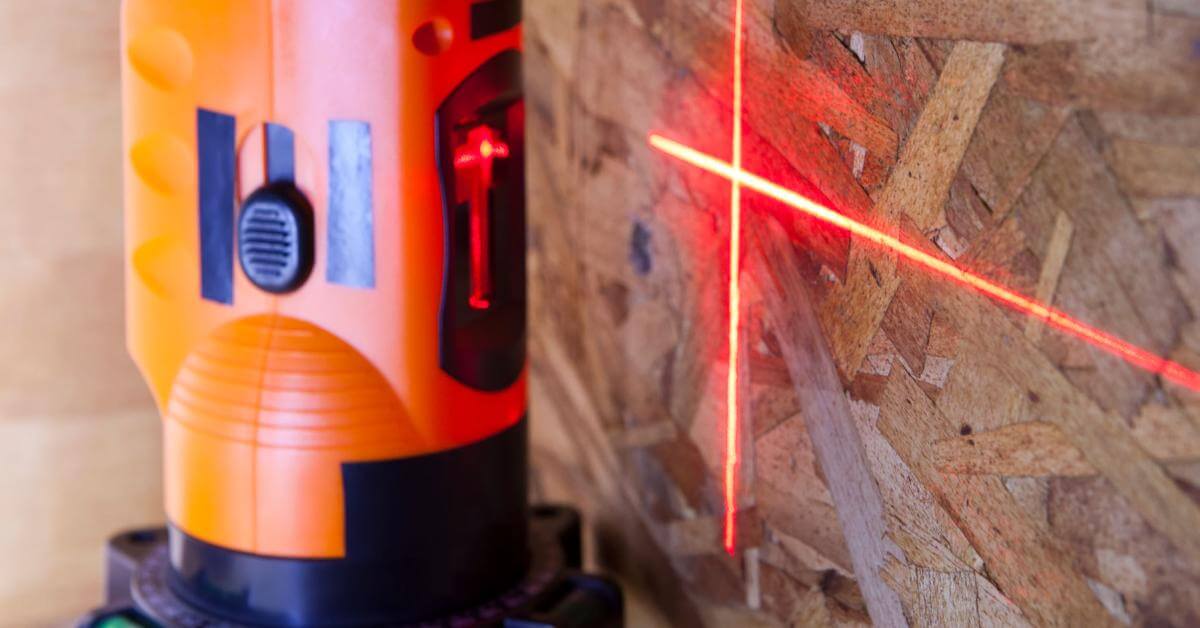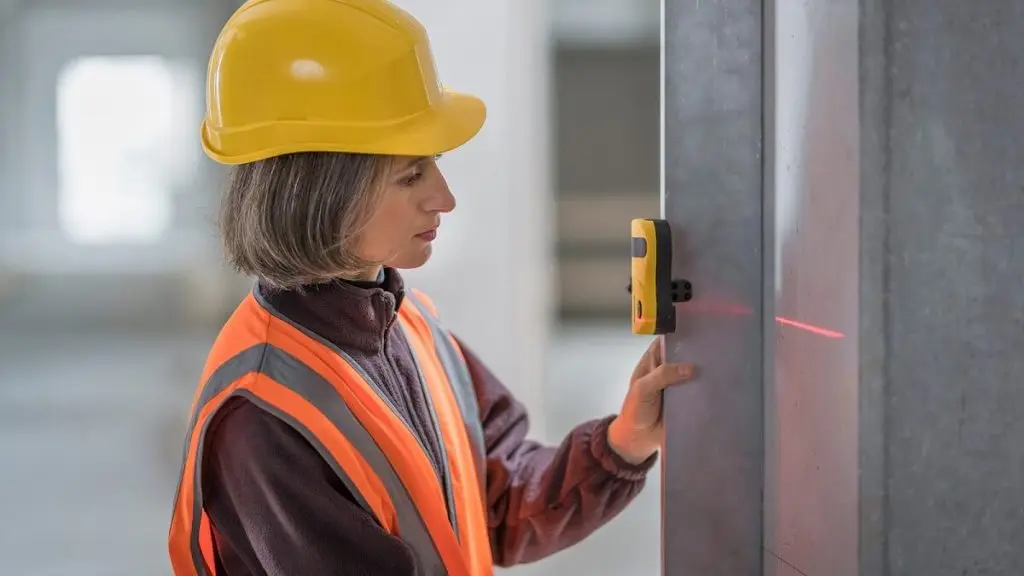Laser levels are tools for getting precision or alignment during a construction project. These devices project straight beams to help you determine if a surface is leveled. It’s also a crucial tool for professionals and individuals who like to dabble in several DIY projects.
If you’re in the market for a reliable laser level for your construction and DIY projects, we recommend that you buy from VEVOR. The brand sells durable, high-performing laser levels that’ll simplify your tasks. Whether you’re framing a wall or installing new tiles in your bathroom, VEVOR laser levels are effective for multiple tasks.
This article will provide answers and insights on several things regarding laser levels. So, if you have been asking, “How does a laser level work?”, or you need more information about its components, and the best ways to use it, you can find all the answers here.
Table of contents
What is a Laser Level?
A laser level projects a straight laser beam to create a straight line or plane. A laser’s primary use is to ensure objects are leveled, aligned, and plumbed (vertically straight).
Now, how do lasers work? They emit light through a process of optical amplification and produce coherent beams with light waves that travel in the same direction. These tools use components like a laser diode, a rotating prism or lens, and self-leveling mechanisms. Laser levels can be used to set foundations, install floors and cabinets, and execute several DIY projects.
Key Components of a Laser Level
It is important to understand the key components of these tools and how they are assembled to know their precision and functionality. Each component provides distinct functions, which help in bringing your projects to life. Some of the major parts of the tool include:
Laser Diode
The laser diode is the core element of a laser level. It converts energy into a concentrated beam of light. This light forms the laser beam used for leveling.
Collimator Lens
The collimator lens aligns the emitted light into a parallel beam. Without this lens, the laser light would spread out and lose its accuracy over long distances.
Spinning Mirror/Rotary Prism
The spinning mirror or rotary prism creates a sweeping laser beam motion. These motions allow the laser level to project lines or planes across a workspace. The laser level creates a 360° vertical or horizontal line when the beam is rotated.
Leveling Base
The leveling base keeps the laser level aligned. This base is mostly bubble vials for manual or self-leveling mechanisms that adjust automatically. The self-leveling feature uses internal sensors to detect and correct any slight tilts.
These four components must be in perfect shape for the laser level to perform various tasks precisely.
How Does a Laser Level Work?
To understand how a laser works, you must understand its key components and how they work together to ensure the tool is in perfect shape. This is the science behind laser levels.
The Science Behind Laser Levels
A laser level emits a lower laser beam from the laser diode. The collimator lens aligns this beam into a straight, parallel line. The spinning mirror or rotary prism moves the beam in a sweeping motion to project a visible line or plane across a surface. Self-leveling mechanisms in the base ensure the device remains accurate, adjusting for any slight tilts to maintain precision even on uneven surfaces.
Types of Laser Levels
There are several kinds of laser levels, each with their own specific features. We look closely at the three main types of laser levels below:
Dot Lasers
Dot lasers project a single point of light. They’re useful for marking exact spots for drilling or installing electrical outlets. The laser diode emits a focused beam, and the collimator lens refines it into a precise dot.
Line Lasers
Line lasers project horizontal and vertical lines. They’re commonly used for aligning tiles, windows, doors, or even hanging pictures. You can consider investing in line lasers if you need laser levels to accomplish your DIY tasks.
Rotary Lasers
Rotary lasers can go 360°. The collimator lens moves the beam of light from the diode into the rotating prisms, which, in turn, creates a full circle line around the tool. They provide extensive coverage for large construction sites and outdoor projects. You can use it for grading, excavating, and other large-scale layout works.
Practical Uses of Laser Levels
Laser levels are versatile tools that come in handy in many tasks. Whether you’re a professional in the construction industry or a DIY hobbyist who needs a leveling tool lasers are usually a perfect option. These are some practical uses of laser levels:
Construction Projects
In construction, laser levels align walls, floors, and ceilings. They guide the constructors in keeping structures perfectly level and aesthetically pleasing. For instance, when installing ceilings and floors, laser levels can help achieve a smooth, even surface and prevent issues that might come from uneven foundations.
DIY Home Improvement
A laser level is one of the essential tools you must invest in if you are involved in DIY home improvement projects. You can use the tools for many purposes, including:
- Hanging pictures: Laser levels will help you achieve the perfect picture alignment.
- Installing cabinets: Laser levels can keep your cabinets perfectly level and evenly spaced.
- Building decks: They are essential for keeping the deck surface leveled.
- Setting up furniture: They are used for aligning the furniture pieces with the rest of the room during setup.
Landscaping and Grading
When landscaping, laser levels ensure even land surfaces, which is needed for proper drainage. The rotary laser lever is a good choice for land grading, as it projects a 360° line that helps landscapers maintain a consistent slope in large areas. Precise leveling will prevent water pooling, and you can also make use of this when laying out a new garden bed or leveling the ground for a patio.
The ability of these tools to provide precise measurements and alignment makes any task easier, especially in professional settings. Ultimately, they reduce the chances of making mistakes and save you from the pain of having to rework projects from scratch.
Advantages of Using a Laser Level
Laser levels have several benefits and uses for both professionals and individuals who use them. We discuss some of the perks of using a laser level in this section.
Precision and Accuracy
Laser levels help you make accurate construction decisions. We recommend getting the VEVOR laser level for your professional construction tasks because of its superior precision and accuracy compared to traditional leveling tools. VEVOR’s self-leveling Laser Level has an IP54 rating and a bright laser beam with ± 1/9 inch at 33 ft high and 100 ft distance accuracy. You need this high level of accuracy to get exact measurements and alignments when installing tiles, framing walls, or even setting up partitions.

Time Efficiency
Laser levels speed up project completion because you don’t have to bother about redoing mistakes. These tools also eliminate the need for time-consuming manual measurements—all you need to do is turn them on to get accurate measurements. The self-leveling feature in VEVOR laser levels also enhances efficiency by automatically adjusting to maintain its accuracy.
Versatility
Laser levels are versatile and can be used in various applications, from construction to DIY to home improvements. Their ability to project both horizontal and vertical lines makes them adaptable to different uses and tasks.
Limitations and Considerations
While laser levels offer numerous advantages, like every other tool, they come with some limitations. We discuss these potential limitations and some factors to consider for optimal use of these powerful tools in this section:
Potential Drawbacks
One potential drawback of laser levels is visibility issues in bright light. You may find it difficult to see the laser line outdoors or in brightly lit environments, which can disrupt its accuracy. Traditional laser levels can, sometimes, have range limitations. The effectiveness of their laser beams dims over long distances, which can be problematic for large-scale projects.
Tips for Optimal Use
- You must get the right type of laser level for your project and space to enjoy optimal performance. Dot lasers are perfect for pinpoint alignment, while rotary lasers are better for large areas.
- You should properly set up and calibrate your laser levels to ensure they are correctly positioned and leveled before use.
- Do regular maintenance on your tool. Check the calibration and clean the device. This will help maintain accuracy and also extend the tool’s lifespan.
How to Use a Laser Level

After buying a quality laser level, the next step is to use it to execute your projects. For experienced professionals, there is probably no need for this guide. However, if you are new to laser levels, you will need to understand how to properly set it up and operate it for optimal performance. You also want to be aware of the required safety measures. We have provided a useful guide on how to use laser levels optimally and safely in this section.
Setting Up
Place the laser level on a stable surface or tripod, and ensure it is level — you can use bubble vials for this or use its self-leveling feature if it has one. Calibrate the device according to the manufacturer’s instructions to ensure it projects accurately.
Operation
Turn on the laser level and project the beam onto your work surface. Align it with your desired marks for horizontal or vertical tasks, and adjust your work to match the laser lines for precise alignment and leveling.
Safety Tips
Always protect your eyes from the laser beam—use safety glasses if necessary. You should also handle the device carefully to avoid damaging it. Store it properly when you’re not using it, as the instruction manual directs.
Conclusion
Laser levels are a game-changer when it comes to getting precise measurements in your professional and DIY projects. These tools save time by offering precise and accurate measurements, and they are renowned for being useful for several projects.
While there are several options out there, we advise that you buy VEVOR’s laser levels due to their exceptional features. These lasers are ideal for both professional and DIY tasks. They are tough, durable, and offer excellent and accurate readings. They also come at affordable prices compared to the standard industry rates. Visit the VEVOR website today to explore their range of impressive laser levels and invest in precision for your next projects.





